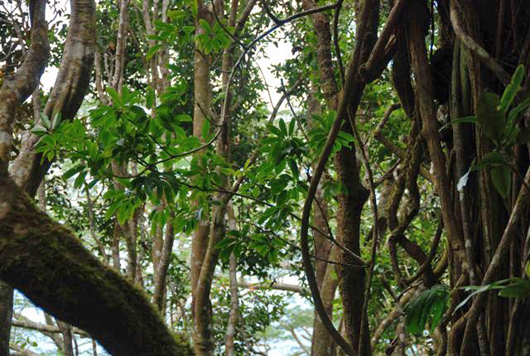Seychelles: More news from an Island Paradise...
11.11.09
The Seychelles are a group of 115 islands sheltering in the Indian Ocean. Famous for honeymooners lounging on sandy beaches, they appear a paradise on earth. But beneath the coconut palms you will see people and nature trying hard to get along.
The wildlife of the Seychelles has suffered since it was first inhabited. Forests were felled, introduced species ran amok, and several timber species were almost lost - saved only by their inaccessibility. The 75 endemic plant species were perhaps hit hardest as their habitats succumbed to the rapid changes. But things are changing.
Katy Beaver from the Plant Conservation Action group (PCA) in theSeychelles keeps us up-to-date on the turning of the tide.
Since the last report from the Seychelles plant conservation world early in 2008, much has happened. For one thing, a long-lost plant not seen on the main island of Mahé for 100 years has recently been re-discovered in the remote area where it was first recorded. The plant is Schefflera procumbens, an epiphytic woody creeper, which was previously assumed to be restricted to Silhouette Island and extinct on Mahé. As our very small NGO, Plant Conservation Action group (PCA), this month celebrates its 7th year of existence, this news has something of a birthday present feel to it; especially as it was one of our members who found the Schefflera!

Schefflera procumbens recently rediscovered on Mahé © Bruno Senterre
During the past year we have welcomed several new members, including joyfully a couple of budding young botanists. Although there are several people with vast field expertise, experience and knowledge of the Seychelles flora, we still lack a fully trained Seychellois botanist in the country, so we hope that at least one of these students will be allowed to do a full botany degree.
Currently there are several large environmental projects underway in Seychelles, funded by the Global Environment Facility (GEF). PCA has been actively involved in these projects in spite of the fact that most of us have full time jobs and we have no paid staff. One of the projects relates to sustainable land management and members are assisting with a study of vegetation rehabilitation after fire, particularly on the islands of Praslin and Curieuse, where there is a history of human-induced fires followed by severe erosion after heavy tropical rain. The soil later becomes devoid of nutrients and baked hard by the sun, so special techniques have to be employed to enable rehabilitation. Experiments start soon.

The scene after fire tore through an area of native mixed palm forest on Praslin
© Lindsay Chong-Seng
Another GEF project taken on by PCA members has been a review of management of invasive alien species (IAS) in Seychelles. This has included an extensive search through literature, for both plant and animal IAS, and also a questionnaire and research into eradication and control methodologies. A report will be finalised soon.
A vegetation rehabilitation project, to which PCA has been linked for the last four years, is that on North Island, where a five star ecotourism business venture undertook to gradually rehabilitate the whole island (201ha) from a rat-infested coconut plantation to an island of native vegetation free from alien species. Obviously this takes time but already cats and rats are eradicated, native vegetation is establishing and the island is able to provide a natural habitat for threatened endemic animal species such as the Seychelles White-eye and the Seychelles Black Mud Terrapin. PCA has been providing advice and assistance for the vegetation aspects of the project. Here too experimental techniques are being tried, with ongoing monitoring provided by PCA members.
North Island rehabilitation (August 2006) - a coastal coconut area at the start of planting (many coconut palms removed and native seedlings planted, including a native Pandanus)
The same view in September 2009 - what a difference a few years makes!
The tree in the left of the previous photo is now shading out weedy growth, while the Pandanus is growing strongly
Between all this - plus assisting a number of research scientists and overseas students - we have still managed to get out on field trips to give our members a chance to learn more about native plant species, as well as produce our (roughly!) biannual newsletter “Kapisen”. Normally we circulate this digitally but this year we produced a colourful printed edition for schools, with some fun activities about plants as well as articles written by students. Find out more about the work of the PCA and get all the back issues of “Kapisen”, including the special schools issue, from our website.
Related links:
 A new plant research agenda for the Seychelles hopes to prioritise conservation research questions for the next five to ten years that will inform the plant conservation management of the Islands.
A new plant research agenda for the Seychelles hopes to prioritise conservation research questions for the next five to ten years that will inform the plant conservation management of the Islands.